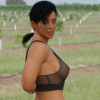IRAY Decals, Geometry Shells/Geoshells, and Seams
 NylonGirl
Posts: 1,931
NylonGirl
Posts: 1,931
So I was trying to find a way to make some lettering and lines and whatnot to appear on the bodies of my characters. First I tried the IRAY Decals, which did cause the imagery to appear on their bddies. But if you move the various parts of their bodies (bones, maybe) then their body parts move outside of the Decal node's cube and then the projection either moves or disappears altogether from the part of the body that moved.
Next I tried creating a Geoshell. And that did make it so my imagery appeard on the characters' bodies, and even moved with their body parts. But the geoshells have separate textures for various parts of the body. So it became impossible to put the image on a place that spanned two of the textures. And as my image software deals with flat images and the textures are wrapped around a female body, there was distortion.
The only other thing I could imagine is to make lots of Decal nodes so there is one for each part of the body that moves. And regardless of whether I use Decal Nodes or Geometry Shells, I'm going to have to make a lot of small textures instead of one big one. It's a lot of work for something that used to be simple with DecalMaster.
What I'd really like is something like DecalMaster that lets me load a figure and an image, and then lets me drag that image to any part of the figure and generates the necessary textures for me regardless of where the seams are. But DecalMaster is old, and doesn't seem to be updated to be usable with the current technology. I figured there had to be a GeoShell editor since people make products based on GeoShells.
I'm probably willing to spend some money for a product that solves the problem, as I did with DecalMaster long ago. But, as this is a hobby for me, I probably wouldn't spend hundreds of dollars. Is there any solution out there for me?


Comments
Have you tried LIE? Click on the arrow next to, for example, base color, and a menu will pop up. Select Layered Image Editor, and plop your image onto a new layer.
I had not tried the layered image editor before. But after trying it, I think I must just not know how it works. I created a new layer for the "Skin" category in the surface tab. I chose to add a new layer in the "Base" category and clicked on "Resource" and selected my texture. But I ended up with the new texture covering the entire figure, appearing to replace or completely hide the character's original texture. Changing the scale didn't seem to help. I didn't see an option for a transparency map.
The overlay you add as a new layer in the LIE needs to have it's own transparency map. It is limited in what rotations are available *just 90 degree increments) so if you wnat teh lettering, lines, etc., to follow the line of a limb, say, youy'd be better creating/editing said lettering linein an image package (such as GIMP orPhtoshop) with an example of the texture map as a guideline, then removing that before saving the image to be used as th eoverlay - not forgetting to save it with a transparency lyer and in a format that supports them, such as .png.
had you parented the decal to the part of the body it was related to? I like decals especially when you have to deal with seams. Should seams in particularly.
Did you try the UV-mapping option for the decals, instead of projection mapping? Those should move with the body. Though, you will have to make your decals so they utelize the whole UV-map. Obvious potential issues where the natural seams would be, at arms, neck etc... You would have to do a bit of trial and error editing to get them to match, since you are not making the acutual UV map.
Have you tried grouping the decal node to the model? I know that only helps if the decal is isolated to specific body parts, but you could creatively avoid those problem areas. (Difficult if you are doing animations with them.)
The best part about the UV-mapped projection, is that you are NOT bound to the lower-detail skin image. Your decal image can be any image size. (As long as it is proportional, it should all be fine.) EG, the skin may be 2048x2048, but your decal can be 8096x8096 as an example. Just keep in mind that you will have to adjust the Medium and High threshold values in the advanced settings, so Daz doesn't, "compress the images to smaller sizes", when it renders with them.
Defaults are 512 for medium threshold and 1024 for high threshold. (Now you know why your 2048x2048 images don't look clear when they render. Daz reduces them all to 1024x1024 before they are used for a render. Including background images, which should never be compressed, because they are backgrounds!)